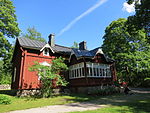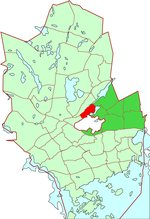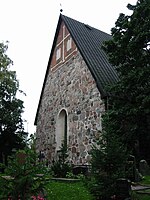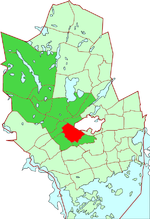Espoo (, Finnish: [ˈespoː]; Swedish: Esbo) is a city and municipality in the region of Uusimaa in Finland. Espoo is situated on the northern shore of the Gulf of Finland and borders Helsinki, Vantaa, Kirkkonummi, Vihti and Nurmijärvi. The city also includes the enclave of Kauniainen. The city of Espoo covers an area of 528.03 square kilometres (203.9 sq mi) with a population of 311,888, placing it as Finland's second most populous city. Espoo is part of the Helsinki Metropolitan Area, where more than 1.5 million people reside.Espoo was settled in the Prehistoric Era, with evidence of human settlements dating back 8,000 years. However, the population disappeared during the early Iron Age. During the Early Middle Ages, the region was populated by Tavastians and Southwestern Finns. Following the Northern Crusades, Swedish settlers began to emigrate to the coastal regions of modern-day Finland. Espoo was subsequently founded as an autonomous Catholic parish in the 15th century. Following the conclusion of the Finnish War, the decision to make Helsinki the new capital of the Russian-controlled Grand Duchy of Finland in 1812 had a significant positive impact on the municipality's growth and development. Nevertheless, the territory continued to be mainly agrarian until the twentieth century. In the years that followed World War II, Espoo underwent swift urbanization and significant demographic shifts, with Finnish becoming the majority language around 1950, replacing Swedish. The municipality attained market town status in 1963 and was subsequently granted city status in 1972.The city is characterized by a suburban landscape dominated by detached housing. Additionally, it is recognized for its expansive natural surroundings such as a 58-kilometre shoreline, an archipelago, forests, lakes, and a national park. Administratively, Espoo is divided into seven major districts, with each being further divided into smaller districts and neighbourhoods. Unlike traditional cities, Espoo does not have a central city area. Instead, it has five distinct city centres, namely Leppävaara, Tapiola, Matinkylä, Espoon keskus and Espoonlahti. Additionally, Espoo has numerous local centres formed around historical manors.Aalto University is situated in Otaniemi, Espoo, alongside a thriving scientific community that comprises various startups and associations such as VTT – the Technical Research Centre of Finland. Espoo is home to several leading enterprises like Nokia, HMD Global, Tieto, KONE, Neste, Fortum, Orion Corporation, Outokumpu, and Foreca, in addition to game developers Rovio and Remedy Entertainment. In 2015, Espoo became a member of the UNESCO Global Network of Learning Cities.










